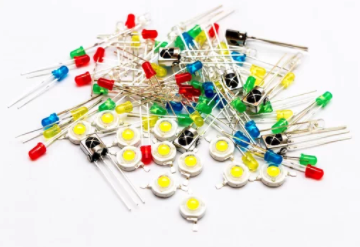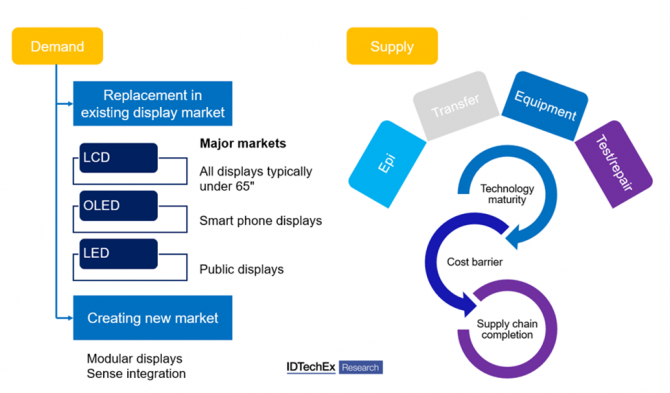
What MicroLED displays mean to the display business
By IDTechEx, Cambridge UK
Electronics Optoelectronics Supply Chain Covid 19 displays LCD LED micro-LED OLED opto optoelectronics trendsBetween hope & hype, Micro-LEDs have the potential to disrupt the display industry
COVID-19 has changed our life completely. One of the influences it brings to us is the new life and work style with a distance between each other. From various statistics, display sales in some applications since COVID-19 have increased, due to the need for people to communicate remotely. COVID-19 is just one factor.
In addition, other factors can show the trends of the display industry. Micro-LED, known by many as a disruptive display technology, has been talked about extensively. What disruptions can Micro-LED displays bring to us, and will the future displays require Micro-LED technology? What are their potential applications and what are the hypes and realities?

Source: Adobe
Differentiations of regional development
The global landscape for LCD seems to be clearer. In 2020, Samsung Display sold its Suzhou LCD plant to CSOT, a panel unit of Chinese home appliance maker TCL, for $ 1.08 billion (60%). This merge & acquisition activity indicates Samsung’s exit from the LCD business. LG Display has halted its domestic production of LCD panels. Korean vendors tend to reduce their LCD panel production and shift to QLED & OLED. In addition, quite a few Japanese and Taiwanese companies are either getting out of LCD business or slowing down investment in LCD. As a comparison, LCD manufacturing is shifting to mainland China due to cost competence, new line production efficiency, and industry chain support.
In the OLED area, OLED panel production is dominated by Korean companies in terms of effective production capacity, upstream materials & equipment, downstream application, and supply chain completeness. For instance, SDC and LGD have supported upstream material and equipment companies, building good ecosystems. For the downstream applications, Samsung small/middle-sized OLED panels are firstly supplied to Samsung smartphones, while LGD large-sized OLED panels are firstly offered to LG TVs. Their brands can also provide enough support and feedback. Samsung and LG are dominating small/middle and large-sized OLED panels, respectively.
New display technology
Regarding the core upstream materials and equipment, Japan and Germany are very strong. Their advantages can be applied to not only LCD or OLED but other potential new display types as well.
With this background, getting involved in a new display technology could bring new opportunities to the relevant players, as a new display technology can break the current regional clusters and advantages, forming a new industry structure and thus make a differentiation.
Display industry trend
The crystal cycle is a business cycle in the active-matrix LCD industry that underlies display industry trends. The excess investments can cause surges in the amount of production capacity and lead to overcapacity and price drop. Then closure of old fabs and consolidation occurs, leading to capacity shortage and demand growth. Display makers can make a high profit with the increased demand, which results in a new cycle of investment. Now we can see with over-capacity we gradually come to the consolidation stage. The display crystal cycle trend is quite obvious for the LCD business, but the same trend also applies for Micro- and Mini-LED display areas, especially the latter. There are quite a few display vendors and backplane makers plunging into the Mini-LED and/or Micro-LED business through partnerships, mergers, joint ventures, and acquisitions.
Supply reshuffle under COVID-19
One of the biggest discussions happening in the world right now is the COVID-19. With more and more countries having COVID-19 under control, the question is not the public health only, but also the longer-term effect it throws to us in the social, economic, and political aspects.
Involving multiple existing industries and new industries, Micro-LED displays may shape the existing LED and display supply chain, resulting in a lengthy and complex new one. New technology approaches and new products can also provide new opportunities for the players, such as the CMOS industry can take a position in the Micro-LED-based micro-display supply chain.
Experienced with COVID-19, the global economy and supply chain establishment might be influenced.
Financial markets have been impacted
The perceptions of COVID-19 in February and afterward are quite different. In February, the situation of COVID-19 was the most severe in China. Therefore, many analyses focused on supply chain safety. The risk has been discussed multiple times to further rely on the global industrial supply chains in China. While from March, the global pandemic made people view the situation from a broader angle.
First, global economic growth has been severely downgraded all over the world and the unemployment rate has been increased, even with government support from various countries. Second, the consumer industry has been deeply affected. The purchasing of less necessary products will be reduced both for consumers and business units, although in the display area the situation is more complicated, with the fact that for some applications the sales increased while others decreased. Thirdly, the financial markets have been impacted. Last, but not least, the impact on the global supply chain will remain, both for now and in the future.
Globalization trend
It has been accepted by many that the COVID-19 global pandemic will make U.S.-China relations more tense. Also, globalization is in decline with closed borders, travel restrictions, export conditions, and paralyzed supply chains. With vaccinations taking place in multiple countries, this situation is expected to improve in the next few months. However, the change of public perception may have a longer impact.
On one hand, IDTechEx has heard from a few small companies that they deliberately chose to partner with companies that are less likely to be affected by the trade war. On the other hand, although globalization is still the general trend, regional clusters may play a more important role in supply chain building than a global network in the future.
Unique value propositions
We have seen various drivers from the supply side. While from the demand side, end users are looking for displays with better and better performance, more and more flexible format, and ubiquitous availability. Micro-LED displays have value propositions such as wide color gamut, high luminance, low power consumption, excellent stability and long lifetime, wide view angle, high dynamic range, high contrast, fast refresh rate, transparency, seamless connection, and sensor integration capability, etc. Some features are unique for Micro-LED technology and therefore it is considered a potential game-changer in the display industry.

Demand and supply of Micro-LED displays. Source: IDTechEx
Creating new applications
With some unique value propositions, Micro-LED displays cannot only serve the existing application markets but also create new applications. For instance, the seamless tiling feature can enable standard Micro-LED modules, and then form larger displays with different sizes and customized shapes, realizing a more flexible design.
Another example is the capability for sensors to be integrated into the displays so an interactive display for the future can come true.
Apart from these unique features, combined value propositions can make some applications easier to become a reality. For example, the semi-transparency feature, long lifetime/better stability, flexible design, and high luminance feature of Micro-LED displays are ideal for new displays used in automotive applications, compared with alternative technologies.
What else can we learn?
Taking all these factors into consideration, Micro-LED displays have the potential to disrupt the display industry. In the meantime, there are lots of challenges to overcome and it is important to distinguish between hope and hype.
—————————–
For more information on this report, please visit www.IDTechEx.com/MicroLED, for the full portfolio of research available from IDTechEx please visit www.IDTechEx.com/Research.
